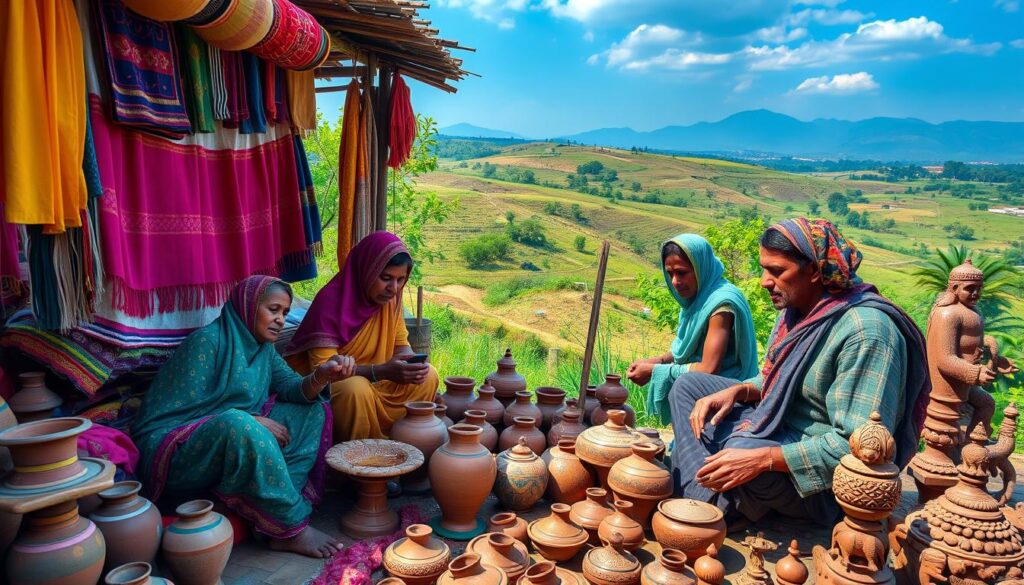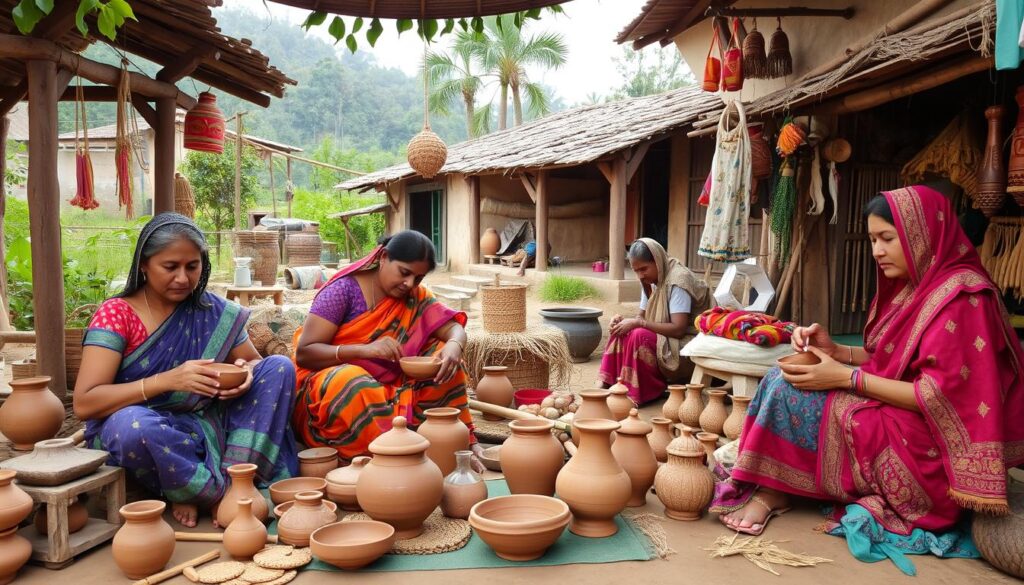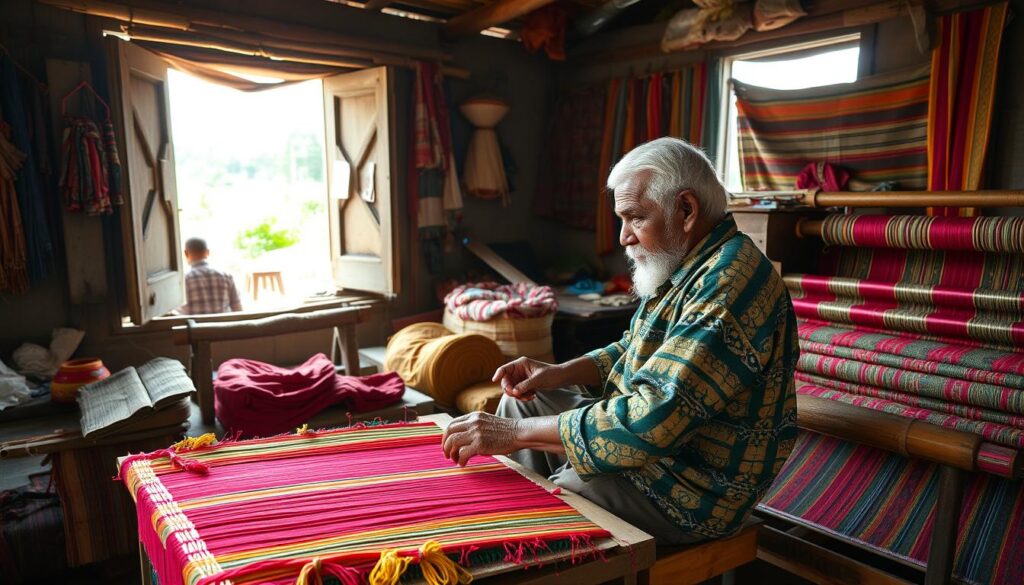In India, the work of rural artisans often goes unnoticed. These *unsung creators* are the lifeblood of our *artisan communities*. They create a rich *cultural heritage* through their *traditional crafts*. Their skills tell stories of our diverse society.
As I explore their stories, I want to highlight their importance. We must celebrate these artisans. This way, we can uncover the many traditions that shape their craft and culture.

Key Takeaways
- The craftsmanship of rural Indian artisans enriches the cultural heritage of India.
- These unsung creators play a vital role in maintaining traditional crafts.
- Recognition of artisan communities is essential for promoting their unique cultural narratives.
- Celebrating these artisans contributes to the preservation of their identities and traditions.
- Understanding their contributions fosters respect and appreciation for handmade artistry.
The Rich Tapestry of Rural Indian Artisan Communities
In India, rural artisans show a wide range of creativity and skill. Each group has its own unique style, shaped by where they live, their culture, and history. Their traditional skills show their deep connection to their surroundings and heritage.
When I visit these communities, I see how important social bonds are. These bonds help artisans work together, share ideas, and create new things. This teamwork keeps their skills alive and tells their cultural stories.

This connection makes their art even more special. Each piece is a story, filled with the community’s experiences and traditions. It shows how vital these communities are to rural India’s culture.
Exploring Cultural Heritage Through Traditional Crafts
In rural India, traditional crafts show off the culture’s rich heritage. They tell the history of a community and its unique identity through art. Each craft has a story, showing the skills passed down through generations.
Defining Traditional Crafts
Traditional crafts are handmade items that show a region’s skill and art. They use old methods and materials, showing the culture’s impact. Items like textiles, pottery, woodwork, and metal crafts show the artisans’ skill.
These crafts are special because they are both useful and tell a story. They connect the past and present.
The Evolution of Craft Techniques
Traditional crafts have changed over time but kept their core. Artisans have updated their methods to meet today’s needs. This keeps the crafts’ value and appeal alive.
By mixing old and new, artisans keep India’s traditional crafts vibrant. This blend makes the crafts relevant and interesting to today’s people.

Unsung Creators: Unveiling the Subcultures of Rural Indian Artisans
The world of rural Indian artisans is filled with unsung creators. They shape their communities with unique craft stories. Each artisan comes from a specific place and culture, making their work a big part of who they are.
These subcultures are key to keeping Indian craftsmanship alive. They help preserve the detailed traditions of Indian art.
Looking into these subcultures shows how artisans find their identity. They are influenced by local traditions and their own life stories. The skills they learn from their families show their own talent and add to India’s culture.
I’ve seen how these artists tell their stories through their work. Each piece shows their background and feelings.

Really, getting to know these artisan subcultures helps us value the art from India’s villages more. By seeing the important roles these communities play, we help tell the story of craftsmanship that makes India richer.
The Role of Indigenous Artisans in Preserving Artistry
Indigenous artisans are key to traditional craftsmanship in India. They work hard to keep art alive for future generations. By sharing traditional techniques, they make sure these art forms stay alive, even when times change.
They pass on cultural practices and community knowledge through their crafts. For example, they teach their kids how to weave or make pottery. This keeps their heritage and skills alive, connecting them to their community.
Artisans face many challenges today, but they adapt while staying true to their roots. Supporting them is important for our cultural heritage. When we invest in their work, we help keep their traditions alive for years to come.

Showcasing Exquisite Indian Handicrafts
Indian handicrafts show a wide range of exquisite crafts that highlight our rural artisans’ rich cultural heritage. I’m always amazed by the creativity and detail in these artisan products. From the detailed pottery designs to the bright colors of textiles, each piece has its own story.
In Rajasthan, artisans create beautiful hand-painted pottery. In Andhra Pradesh, weavers make stunning cotton fabrics with complex designs. Brassware from Moradabad is both useful and a masterpiece, showing traditional skills passed down through generations. Each item is made with love and care, connecting us to its cultural roots.
Exploring these artisan products, I see the heart of Indian culture. Buying these handicrafts helps the artisans and deepens our respect for their dedication. The mix of tradition and modernity in these crafts makes them highly valued worldwide.
Connection Between Rural Artistry and Local Economies
The world of rural artistry is a key part of local economies. Artisans help keep economies stable with their sustainable work. They make unique crafts that reflect local traditions and use local materials, supporting *sustainable development*.
At *craft fairs*, artisans show off their talents. These events bring attention to their handmade items. They also boost the *economic impact* of artisan communities. When locals buy from these businesses, artisans’ financial health improves.
- Artisans create job opportunities in their communities.
- They promote local culture and heritage through craftsmanship.
- The focus on local production helps the environment.
Supporting rural artistry creates a positive cycle. Artisans do well, cultural heritage stays strong, and *local economies* grow. This shows how vital it is to back artisanal work for a bright future for creators and their communities.
The Importance of Artisanal Knowledge Transfer
Artisanal knowledge transfer is key in keeping traditional crafts alive. It makes sure that important skills and methods are passed on. Mentorship is vital in this process, letting experienced artisans teach the next generation.
This sharing of knowledge helps grow skills and brings new ideas to the craft. It makes the craft richer and more innovative.
Artisans also teach through community education. They create spaces where learning happens. Hands-on learning helps people understand complex techniques and connect with their cultural roots.
This mix of mentorship and knowledge transfer builds a strong respect for traditional crafts. It encourages artists to explore and grow in their craft.
- Establishing mentorship programs in local communities strengthens bonds between generations.
- Skills development workshops enhance the quality of craftsmanship.
- Community education initiatives promote awareness of traditional techniques.
Spotlighting Different Artisan Crafts Across Regions
In my journey through India’s artisan crafts, I’ve seen amazing regional diversity. Each area has its own cultural influences that shape the crafts. For example, Punjab’s phulkari and Odisha’s silverwork show off unique craft specifics.
Some standout artisan crafts include:
- Rajasthani Block Printing: Its bright colors and traditional designs reflect the desert state’s rich culture.
- Kashmiri Pashmina Weaving: Known for its softness, Pashmina shows top-notch craftsmanship and detail.
- Kerala’s Mural Painting: These paintings tell stories of history and local tales, rooted in temple art.
- Goa’s Feni Bottle Art: This craft uses recycled materials, blending creativity with sustainability.
Every region in India has its own set of artisan crafts. These crafts tell the stories of their people. It’s amazing to see how they evolve yet stay true to their roots. This journey shows the deep bond between local communities and their art, celebrating India’s rich culture.
Modern Challenges Faced by Rural Artisan Communities
Rural artisan communities face many challenges today, mainly because of globalization. This global trend makes it hard for them to keep up with the economy. It threatens the survival of traditional crafts that have been in families for years.
Artisans struggle to compete with cheap, mass-produced items. This makes the value of handmade goods seem less important to buyers.
Globalization also opens up new markets for artisans. But, these opportunities can be costly. They might lead to the loss of local crafts’ unique qualities.
This shift can harm cultural preservation. Artisans may have to change their ways to fit modern tastes. This can mean losing the true essence of their craft.
We need to tackle these economic issues and protect rural crafts. Supporting fair trade and valuing real craftsmanship can help. This way, we can keep artisans working and preserve their cultural heritage.
Promoting Sustainability in Crafts: A New Era
The push for sustainability in crafts is a big step for artisans in India. More artisans are using eco-friendly methods. These methods help their work and the planet.
Artisans are making products that appeal to those who care about the environment. They use materials that are good for the earth and last longer. For example, they’re choosing natural dyes and local materials. This cuts down on pollution and helps local businesses.
Sustainable crafts are becoming more popular. This is because people want to buy products that are good for the planet. This trend helps both artisans and the environment.
Working together, artisans can make a bigger difference. They share ideas and resources. This makes their craft better and helps the planet.
Artisans are changing how they see nature and culture. By focusing on sustainability, we help them succeed and protect the planet. This new era is about finding a balance between creativity, money, and caring for the earth.
Building Networks: The Power of Artisan Collaborations
In my journey through rural artisan communities, I’ve seen how networking changes everything. Artisan collaborations open doors to creativity and exchange. This exchange builds communities and brings artisans into the spotlight.
When artisans work together, their efforts grow stronger. They share resources and knowledge, making their crafts better. For example, by teaming up, artisans can market their work to more people. This creates strong bonds with customers and helps the community grow.
In places where artisans unite, success stories abound. These networks make artisans feel part of something bigger. They share tips and grow together, keeping their crafts alive.
- Shared marketing initiatives, boosting visibility
- Pooling resources, saving costs
- Mentorship, passing on knowledge
Community-focused networks help artisans succeed together. Through teamwork, they face challenges head-on and keep their crafts alive. Building these connections sparks a spirit of collaboration, opening up endless opportunities for artisans and their communities.
A Call to Action: Supporting Rural Indian Artisans
Exploring the world of rural Indian artisans, I see their huge talent and role in keeping cultural heritage alive. It’s key to support these artisans to keep traditional crafts alive and support their communities. We must stand with these creators and give them the power to thrive.
Getting involved in local initiatives is a powerful way to boost local craftsmanship. Going to awareness events helps bring artisans’ stories to light and teaches people about the value of buying local. When we choose local products, we get unique items and help the economy grow.
To really help, consider these steps:
- Check out local markets and fairs where artisans show their work.
- Support websites and stores that highlight handmade items and artisans.
- Use your social media to spread the word about traditional crafts.
- Help out or donate to groups that help artisans and teach them.
By taking part in these actions, we help keep ancient skills alive. Let’s support those who make our lives richer with their art and skill.
Conclusion
Rural Indian artisans are more than just craftsmen; they are vital stewards of our cultural heritage. Their craftsmanship embodies the countless traditions and narratives that have thrived for generations. This article has explored the profound richness of artisan communities and highlighted the vital role they play in the artisan movement.
As we navigate through a world increasingly driven by mass production, it is essential to foster a sense of cultural appreciation. Supporting these artisans is not just an act of goodwill but a strategic investment in preserving our identity. Each handmade piece tells a story that reflects the diversity and creativity embedded in Indian culture.
My hope for the future lies in a collective effort to uplift these artisans. Ensuring their crafts flourish and inspire new generations is key. Recognizing and bolstering their endeavors is a meaningful contribution towards safeguarding their livelihoods and India’s cultural fabric.
As I conclude, I invite all readers to take an active role in promoting and supporting the incredible work of rural artisans. Let’s help ensure their stories continue to be woven into the tapestry of our shared heritage.
No responses yet